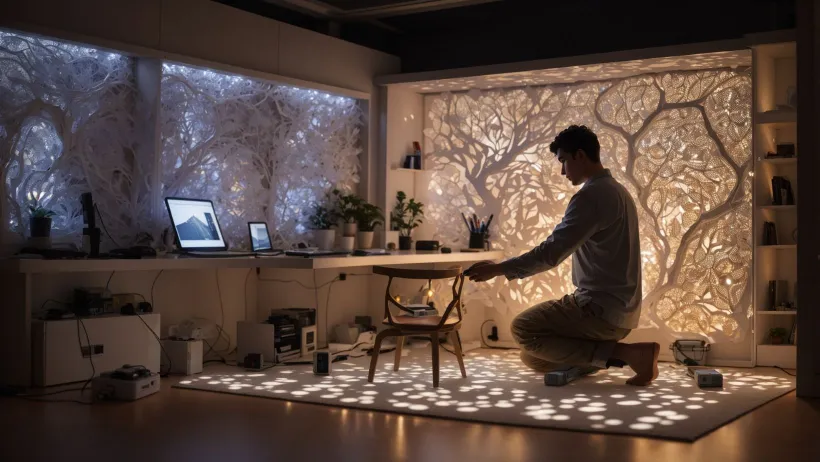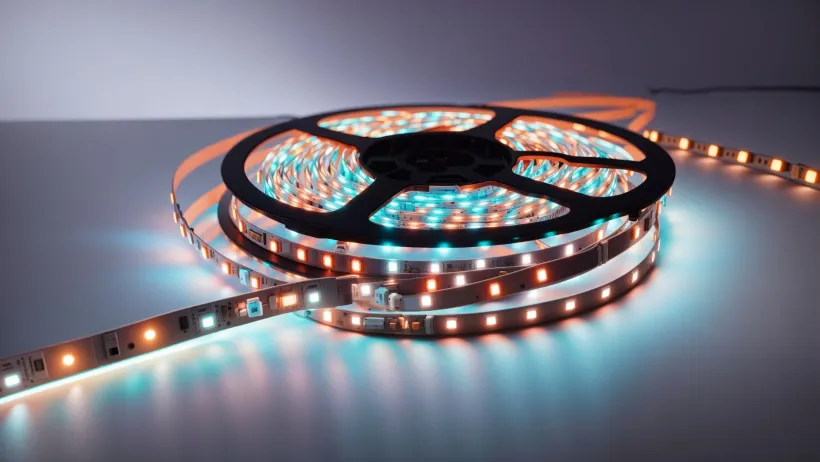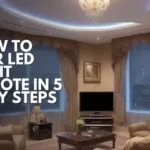Can You Sleep With LED Strip Light ON? In short, yes, it is physically safe as long as the wires aren’t pinched. LED lights are energy-efficient and emit minimal heat, reducing any potential risks. However, there are crucial factors to bear in mind.
Can You Sleep With LED Strip Light ON – 4 Factors to Consider:

1. Sleep Disruption:
Alright, here’s the scoop: LED lights emit wavelengths that can play tricks on our sleep patterns. They can throw a curveball at melatonin production, which is our body’s way of saying, “Time to hit the hay!” So, it might take a little longer to doze off, and your REM sleep might get a tad wonky.
2. Decreased Melatonin Secretion:
Using LED lights at night could put a damper on melatonin production. Translation? It might take a smidge longer to fall asleep and stay that way.
3. Prolonged Sleep Latency:
Fancy term, right? Sleep latency just means it might take you a bit longer to slip into dreamland when there’s LED light in the mix.
4. Health Risks:
Sleeping with the lights on could possibly up the ante on health concerns like heart issues. This could be due to the disruption of your body’s natural sleep-wake rhythm, which is closely linked to how much light you’re soaking in.
Read more: Is it Safe to Cover LED Lights? 10 Tips and Reasons
Mitigating Disruptions:

Now, let’s talk solutions:
Opt for Red LED Lights: is it bad to sleep with red led lights on?
If you’re rocking LED lights, go for the red ones. They’re a bit easier on your melatonin levels.
Adjust Brightness Levels:
Tone down the brightness a bit. Your sleep quality will thank you!
Use Eye Masks or Blackout Blinds:
Time to get cozy! Block out any extra light with an eye mask or blackout blinds.
Power Down Electronics:
Give those electronic buddies a rest too. Less light means a better shot at some quality shut-eye.
To wrap it up, snoozing with LED strip lights is totally safe, but keep in mind how they might affect your sleep quality. By going for red lights, tweaking the brightness, and creating a calming sleep environment, you’ll be on your way to dreamy nights with your LED buddies. Happy snoozing!
What is melatonin?
Melatonin is a hormone generated by your brain’s pineal gland. It is mostly in charge of managing your body’s circadian rhythm in order to maintain your natural sleep cycle. As a result, it’s frequently utilized as a sleep aid to treat conditions like insomnia.
Melatonin regulates immunological function, blood pressure, and cortisol levels in addition to enhancing sleep. Furthermore, it functions as an antioxidant, with some study indicating that it can have a substantial impact on a variety of health concerns.
Read More: 10 Best Tips on how to Change LED Light Colors Without Remote
Can I use a night light instead of LED strip lights?

Night Lights: A Gentle Glow for Peaceful Nights
Night lights are like those little buddies that offer a soft, soothing light at night. They’re perfect for places like bedrooms, hallways, or bathrooms, giving you just enough light to get around without waking up the whole house. Plus, they’re designed to be super energy-efficient and won’t mess with your sleep patterns.
LED Strip Lights: Your Ticket to a Colorful Wonderland
LED strip lights are like the rockstars of lighting! They’re these flexible boards covered in tiny LED lights that come in all sorts of colors and brightness levels. People love using them to spruce up their homes, set the mood, and even create different vibes. You can turn a room into a total work of art, set up a gaming zone, or have a full-on movie night at home! They’ve got a whole range of colors and effects, so you can totally make it your own.
Choosing Between the Two
If you’re deciding between night lights and LED strip lights, here’s the scoop. Night lights are all about that subtle, calming glow at night. They’re champs at keeping things low-key. But if you’re looking to jazz things up, create some ambiance, or just add a pop of personality to your space, LED strip lights are the way to go.
Remember, both have their special powers! So, think about the vibe you want and how you want your space to feel. And of course, if you need more tips or have any questions, I’m here to help! Just give me a shout.
Good colors to sleep with led lights

If you’re looking to set up some LED lights for a good night’s sleep, red or amber are your best buddies. These warm and soothing colors create a relaxing atmosphere that’s perfect for drifting off.
Research shows that blue light, around 450 to 480 nanometers, can mess with your sleep quality and natural sleep-wake patterns. On the flip side, cozy colors like red can help you doze off faster and even give your melatonin production a little nudge.
And remember, personal preference matters too! People tend to fall asleep quicker when surrounded by their favorite light color. So go ahead and pick the hue that feels just right for you.
Can sleeping with LED Lights cause cancer?

The good news is, there’s no solid evidence directly linking the two. However, some studies suggest that too much artificial light at night, including LED lighting, might slightly up the risk of certain types of cancer.
Here’s the deal:
It’s all about melatonin, a cool hormone that helps us sleep and actually has some anti-cancer powers. When artificial light messes with melatonin production and our natural sleep-wake cycle, it could potentially mess with our body’s cancer defense’s.
Quick note:
This isn’t just about LED lights, it’s about all kinds of artificial light. So, here’s a friendly suggestion: try to dial down nighttime exposure to artificial light. You can use devices with blue light filters, and aim for a steady sleep routine. These little steps can go a long way in looking out for your long-term health.
In a nutshell, LED lights aren’t cancer-causers, but it’s always good to be a bit mindful of how they might affect our body clocks. With a few simple moves, you’re setting yourself up for a healthier, brighter future!
Can LED Lights Cause a Fire?

LED lights are pretty safe overall, thanks to their energy efficiency and low heat output. They’re much less likely to start fires compared to older types of lights. But, you still want to be careful with how you use them.
Temperature and Material Concerns
Okay, so here’s the deal. While LEDs won’t suddenly burst into flames, some of them do have materials that can get pretty hot. If you touch them for too long, it can cause burns. Just something to keep in mind.
Safety Tips for LED Lights
Avoid Overloading Circuits: Don’t plug in too many LED lights into a single outlet. It’s like trying to fit too many puzzle pieces – it’s not a good idea and can lead to overheating.
Check Wiring and Connectors: Make sure all the wires and connectors are in good shape. This helps keep things safe and secure.
Keep Away from Flammable Stuff: Don’t cozy up your LED lights with curtains or paper. Give them some space to breathe, so to speak. This way, there’s less chance of anything catching fire.
Turn Off When You’re Out: If you’re leaving the room or heading off to dreamland, make sure to turn off those LEDs. It’s a simple step that can make a big difference in safety.
Give Them a Once-Over: Every now and then, give your LED fixtures a little check-up. Look out for any damage, loose bits, or signs they might be getting too hot. Regular TLC goes a long way!
Conclusion
Sleeping with LED strip lights is safe as long as the wires aren’t pinched. LED lights are energy-efficient and emit minimal heat, reducing potential risks. However, they can disrupt sleep patterns by affecting melatonin production, decreasing melatonin secretion, prolonging sleep latency, and increasing health risks like heart issues.
To mitigate these disruptions, opt for red LED lights, adjust brightness levels, use eye masks or blackout blinds, and power down electronic devices. By adjusting brightness, creating a calming sleep environment, and using red lights, you can achieve better sleep quality. By following these guidelines, you can enjoy dreamy nights with your LED strip lights.
FAQ- Can You Sleep With LED Strip Light ON
Is it safe to sleep with LED strip lights on?
Yes, it is safe to sleep with LED strip lights on. LED lights emit very little heat, so they are not a fire hazard. Additionally, LED lights do not produce any harmful radiation.
Will LED strip lights disrupt my sleep?
LED lights do emit light, which can disrupt sleep. However, the amount of light emitted by LED strip lights is typically very low. Additionally, the color of the light can also affect sleep. Red and orange light are less disruptive to sleep than blue light.
What is the best color of LED strip lights for sleep?
Red and orange LED strip lights are the best colors for sleep. These colors are less disruptive to the production of melatonin, a hormone that helps to regulate sleep.
How bright should LED strip lights be for sleep?
The brighter the light, the more disruptive it is to sleep. For best results, use LED strip lights on the dimmest setting possible.
Should I turn off my LED strip lights before I go to sleep?
If you are sensitive to light, it is best to turn off your LED strip lights before you go to sleep. However, if you need a little light to sleep, you can leave your LED strip lights on in the dimmest setting possible.











1 thought on “Can You Sleep With LED Strip Light ON|Reasons and Solution (2023)”